
British postcard in the Picturegoer series, London, no. W 95. Photo: Metro Goldwyn Mayer (MGM).

British postcard in the Real Photograph series, no. 203. Photo: MGM.
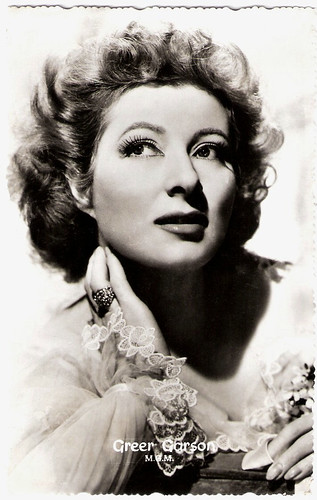
Dutch postcard by Weenenk & Snel, Baarn, no. 1155. Photo: MGM.

Dutch postcard, no. 3016. Photo: Metro Goldwyn Mayer (MGM).
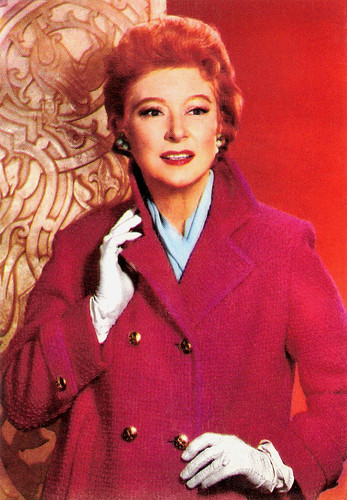
Italian postcard. Photo: Metro Goldwyn Mayer (MGM). Publicity still for The Singing Nun/Dominique (Henry Koster, 1966).
Elegant Manner and Flaming Red Hair
Greer Garson was born Eileen Evelyn Greer Garson in Manor Park, Essex (now Greater London), England in 1904. Garson herself always claimed that she was born in Ireland in 1908. She was the only child of clerk George Garson and his Irish wife, Nancy Sophia Greer. Her father died during an appendectomy when Greer was only two. Her mother provided a living for them by managing townhouses that her husband had owned.
From 1921 on, Greer was educated at the University of London, earning a Bachelor's degree in 1926. She had intended to become a teacher, but instead began working in a research library for an advertising agency, and appeared in local theatrical productions whenever she could.
In 1931, she could start her professional stage career at the Birmingham Repertory Company and she quit her job at the ad agency. She made her first stage appearance as an American Jewish tenement girl in Street Scene. In 1934 she appeared in the short film Inasmuch... (Alec Saville, 1934) with Donald Wolfit. That same year her London stage debut came in The Tempest.
Her role in the play The Golden Arror with Laurence Olivier proved to be her breakthrough. She was suddenly very popular throughout London and offers to headline in plays and musicals poured in. She acted in a variety of plays, ranging from Shakespeare to costume dramas, but none of them were huge hits. She also appeared on BBC television during its earliest years, most notably starring in a thirty-minute production of an excerpt of Twelfth Night (1937), with Dorothy Black.
In 1937, while performing in the play Old Music, she was discovered by MGM mogul Louis B. Mayer. He was in London looking for new talent, and was entranced by her elegant manner and flaming red hair. Garson signed a seven year contract with MGM in late 1937, but did not start to work until late 1938.
When she finally made her first Hollywood film, Garson was already in her mid thirties. Goodbye Mr. Chips (Sam Wood, 1939) was based on James Hilton's short story about a beloved school master. The film was made in England and had a British cast including Robert Donat as Mr. Chips. For the role of his captivating young wife Garson received her first Oscar nomination, but lost to Vivien Leigh for Gone with the Wind (Victor Fleming, 1939).
However, Louis B. Mayer knew he had a star and she was arriving at a great time. Both of MGM's most prestigious actresses, Greta Garbo and Norma Shearer were retiring. Greer was next cast in a fluffy comedy called Remember? (Norman Z. MacLeod, 1939) while Mayer searched for quality roles for his new leading lady.
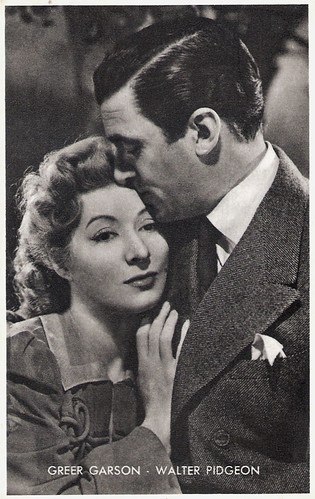
Belgian collectors card by Kwatta, Bois d'Haine, no. C. 167. Photo: Metro Goldwyn Mayer. Publicity still for Blossoms in the Dust (Mervyn Leroy, 1941).
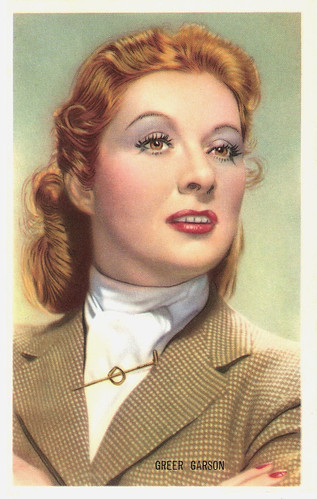
Belgian collectors card by Kwatta, Bois d'Haine, no. C. 203. Photo: Metro Goldwyn Mayer (M.G.M.).
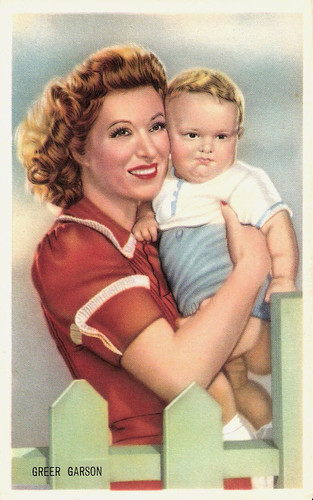
Belgian collectors card by Kwatta, Bois d'Haine, no. C 208. Photo: MGM. Publicity still for Blossoms in the Dust (Mervyn LeRoy, 1941) .
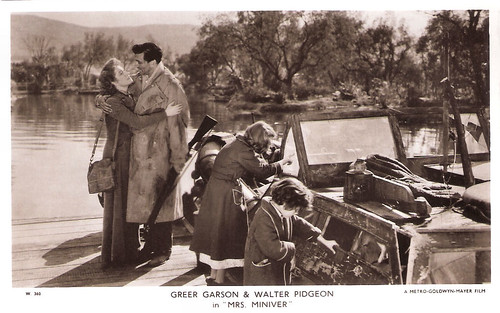
British postcard in the Picturegoer Series, London, no. W 360. Photo: MGM. Publicity still for Mrs. Miniver (1942) with Walter Pidgeon.
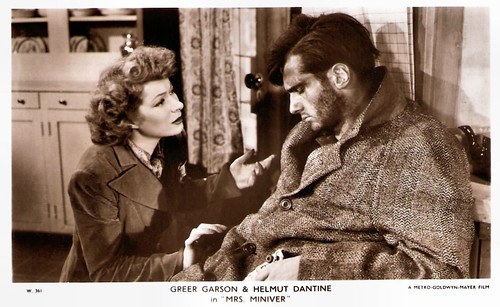
British postcard in the Picturegoer Series, London, no. W 361. Photo: MGM. Publicity still for Mrs. Miniver (1942) with Helmut Dantine.

Belgian collector's card by Kwatta, Bois-D'Haine, Serie C, no. C. 170. Photo: M.G.M. Publicity still for Random Harvest (1942).
One of the 10 Most Popular Hollywood Stars
The next year Greer Garson again received critical acclaim for her role as Elizabeth Bennet in Pride and Prejudice (Robert Z. Leonard, 1940) with Laurence Olivier as Darcy. She quickly became one of the 10 most popular Hollywood stars. She starred with Joan Crawford in When Ladies Meet (Robert Z. Leonard, 1941).
That same year she became a major star with the sentimental drama Blossoms in the Dust (Mervyn Leroy, 1941), which was based on the life of Edna Gladney, who founded an orphanage in Fort Worth, Texas. It was filmed in Technicolor and audiences had their first chance to see Greer's gorgeous red hair. Walter Pidgeon was cast opposite her and their pairing would be repeated numerous times in the future. At AllMovie, Hal Erickson writes: “Greer Garson is dignity and integrity personified in the role of the real-life Edna Gladney.” The film brought her the first of five consecutive Best Actress Oscar nominations.
Garson won the Academy Award for Best Actress in 1942 for her role as a strong British wife and mother in the middle of World War II in the morale-booster Mrs. Miniver (William Wyler, 1942). Hal Erickson reviews: “As Academy Award-winning films go, Mrs. Miniver has not weathered the years all that well. This prettified, idealized view of the upper-class British home front during World War II sometimes seems over-calculated and contrived when seen today. In particular, Greer Garson's Oscar-winning performance in the title role often comes off as artificial, especially when she nobly tends her rose garden while her stalwart husband (Walter Pidgeon) participates in the evacuation at Dunkirk. However, even if the film has lost a good portion of its ability to move and inspire audiences, it is easy to see why it was so popular in 1942-and why Winston Churchill was moved to comment that its propaganda value was worth a dozen battleships. Everyone in the audience-even English audiences, closer to the events depicted in the film than American filmgoers-liked to believe that he or she was capable of behaving with as much grace under pressure as the Miniver family.”
Garson was also nominated for Madame Curie (Mervyn Leroy, 1943), Mrs. Parkington (Tay Garnett, 1944), and The Valley of Decision (Tay Garnett, 1945). Garson was partnered with Clark Gable, after his return from war service, in Adventure (Victor Fleming, 1945). The film was advertised with the catch-phrase "Gable's back and Garson's got him!" Gable argued for "He put the Arson in Garson", and she countered "She Put the Able in Gable!" Thereafter, the safer catchphrase was selected.
The war ended and the public's taste and the studio system in Hollywood began to change. Louis B. Mayer would leave MGM in a few years and Dore Schary would take his place. The elaborate expense once lavished on prestigious MGM films would be curtailed and more attention would be given to films dealing with realism and social issues. ‘Women's films’, the type of movies that Greer Garson excelled in, would no longer be a top priority.
Her downward spiral stopped with the comedy Julia Misbehaves (Jack Conway, 1948) and the hit That Forsyte Woman (Compton Bennett, 1949). The next year she reprised her role as Kay Miniver in The Miniver Story (H.C. Potter, 1950). Unfortunately it didn't fare too well, but Garson remained a prominent film star until the mid-1950s.
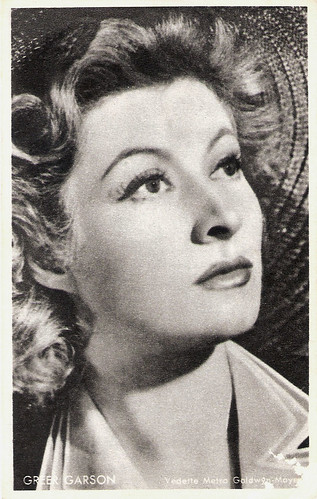
Belgian collectors card by Kwatta, Bois d'Haine, no. C. 2. Photo: Metro Goldwyn Mayer.
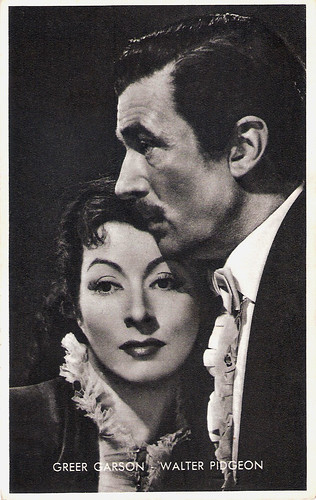
Belgian collectors card by Kwatta, Bois d'Haine, no. C. 167. Photo: Metro Goldwyn Mayer. Publicity still for Mrs. Parkington (Tay Garnett, 1944) with Walter Pidgeon.

Belgian collectors card by Kwatta, Bois d'Haine, no. C. 195. Photo: Metro Goldwyn Mayer. Publicity still for Desire Me (1947) with Richard Hart.

French postcard, no. 850. Photo: Metro Goldwyn Mayer (MGM).

Dutch postcard by S.& v.H.A. Photo: M.P.E.A.
Her Seventh and Final Oscar Nomination
In 1951, Greer Garson became a naturalized citizen of the United States. Her films included The Law and the Lady (Edwin H. Knopf, 1951) and Julius Caesar (Joseph L. Mankiewicz, 1953) starring Marlon Brando. She made only a few films after her MGM contract expired in 1954.
She returned to the stage in late 1957 in the triumphant Auntie Mame on Broadway and earned rave reviews. She had replaced Rosalind Russell, who had gone to Hollywood to make the film version.
In 1960, Garson received her seventh and final Oscar nomination for Sunrise at Campobello (Vincent J. Donehue, 1960), in which she portrayed Eleanor Roosevelt astonishingly accurate opposite Ralph Bellamy as Franklin Roosevelt. This time she lost the Oscar to Elizabeth Taylor for Butterfield 8 (Daniel Mann, 1960).
In The Singing Nun (Henry Koster, 1966) she played the Mother Prioress opposite Debbie Reynolds as the title character. Garson's last film was Disney's The Happiest Millionaire (Norman Tokar, 1967), but she continued to make infrequent television appearances. She narrated the children's television special The Little Drummer Boy (Jules Bass, Arthur Rankin Jr., 1968), which went on to become a classic children's Christmas television program, broadcasted annually for many years.
Greer Garson was married three times. Her first marriage was to Edward Alec Abbot Snelson, a British civil servant who became a noted judge and expert in Indian and Pakistani affairs. The actual marriage in 1933 reportedly lasted only the honeymoon, but was not formally dissolved until 1943. Her second husband, whom she married in 1943, was Richard Ney, the 27-year-old actor who played her son in Mrs. Miniver (1942). They divorced in 1947. Garson claimed that Ney called her a ‘has-been’ and belittled her age. She also testified that he had physically abused her. Ney eventually became a respected stock-market analyst and financial consultant.
That same year, she married a millionaire Texas oilman and horse breeder, E. E. ‘Buddy’ Fogelson. In 1967, the couple retired to their ‘Forked Lightning Ranch’ in New Mexico. They purchased the U.S. Hall of Fame champion Thoroughbred Ack Ack from the estate of Harry F. Guggenheim in 1971, and were highly successful as breeders. They also maintained a home in Dallas, Texas, where Garson funded the Greer Garson Theater facility at Southern Methodist University. In 1975, she appeared at this theatre in The Madwoman of Challiot. It would be her final stage performance.
Garson continued to do television work, appearing in the TV series Little Women (Gordon Hessler, 1978) and The Love Boat (Richard A. Wells, 1982). In 1982, she turned down producer Aaron Spelling's offer of a part in the hit soap Dynasty (1981-1989), to play the mother of Joan Collins's Alexis. She had to give up even these performances in the early 1980s due to chronic heart problems. In 1996 Greer Garson died from heart failure in Dallas, Texas, USA, at the age of 90.
Greer Garson meets Walter Pidgeon for the first time in Blossoms in the Dust (1941). Source: Edatola (YouTube).
Scene from That Forsyte Woman (1949) with Robert Young. Source: Edatola (YouTube).
Sources: Denny Jackson (IMDb), Peter B. Flint (The New York Times), Hal Erickson (AllMovie), Wikipedia and IMDb.
1 comment:
Wonderful post about my favorite actress from this era. Great way to start the week.
By all accounts, Miss Garson's marriage to Fogelson was a happy one, and the two were very active in philantropic activity. I believe they built a college theatre in Santa Fe, NM as well. Thank you Bob.
Post a Comment